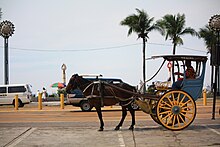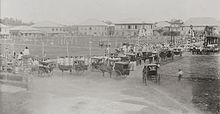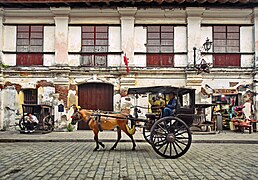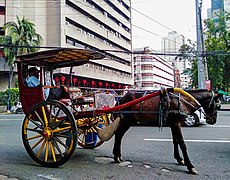
Transportation in the Philippines covers the transportation methods within this archipelagic nation of over 7,500 islands. From a previously underdeveloped state of transportation, the government of the Philippines has been improving transportation through various direct infrastructure projects, and these include an increase in air, sea, road, and rail transportation and transport hubs.

A pulled rickshaw is a mode of human-powered transport by which a runner draws a two-wheeled cart which seats one or two people.

A cart or dray is a vehicle designed for transport, using two wheels and normally pulled by draught animals such as horses, donkeys, mules and oxen, or even smaller animals such as goats or large dogs.
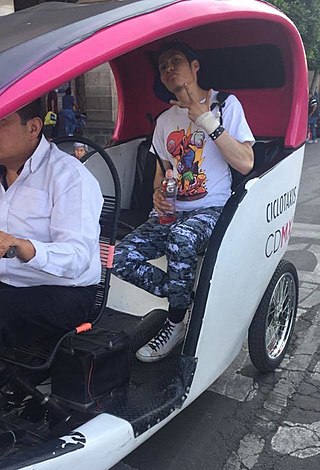
The cycle rickshaw is a small-scale local means of transport. It is a type of hatchback tricycle designed to carry passengers on a for-hire basis. It is also known by a variety of other names such as bike taxi, velotaxi, pedicab, bikecab, cyclo, beca, becak, trisikad, sikad, tricycle taxi, trishaw, or hatchback bike.

Private transport is the personal or individual use of transportation which are not available for use by the general public, where in theory the user can decide freely on the time and route of transit, using vehicles such as: private car, company car, bicycle, dicycle, self-balancing scooter, motorcycle, scooter, aircraft, boat, snowmobile, carriage, horse, etc., or recreational equipment such as roller skates, inline skates, sailboat, sailplane, skateboard etc.

An auto rickshaw is a motorized version of the pulled rickshaw or cycle rickshaw. Most have three wheels and do not tilt. They are known by many terms in various countries including auto, auto rickshaw, baby taxi, mototaxi, pigeon, jonnybee, bajaj, chand gari, lapa, tuk-tuk, tum-tum, Keke-napep, Maruwa, Adaidaita Sahu, 3wheel, pragya, bao-bao, easy bike, CNG and tukxi.

Vigan, officially the City of Vigan, is a 4th class component city and capital of the province of Ilocos Sur, Philippines. According to the 2020 census, it has a population of 53,935 people.
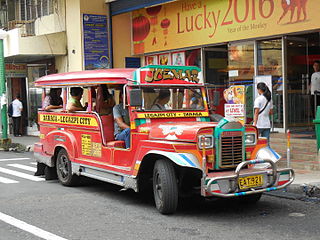
Jeepneys, sometimes called jeeps, are public utility vehicles, serving as the most popular means of public transportation in the Philippines. They are known for their crowded seating and kitsch decorations, which have become a widespread symbol of Philippine culture and art. A Sarao jeepney was exhibited at the Philippine pavilion at the 1964 New York World's Fair as a national image for the Filipinos.

A horse-drawn vehicle is a piece of equipment pulled by one or more horses. These vehicles typically have two or four wheels and were used to carry passengers or a load. They were once common worldwide, but they have mostly been replaced by automobiles and other forms of self-propelled transport but are still in use today.

A tonga or tanga is a two-wheeled cart drawn by a single horse. It is used for transportation in the Indian subcontinent. There is a canopy over the body, one seat faces forward for the driver and one passenger, and one seat faces the rear for a second passenger. Some space is available for baggage below the carriage, between the wheels. This space is often used to carry hay for the horses.

Tiendesitas is a shopping complex located along E. Rodriguez Jr. Avenue in, Ugong, Pasig, Philippines.

The transportation system in Metro Manila covers the road network, rail network, ferries, ports and airports located with the metropolitan Manila area. Road transportation in Metro Manila is diverse, composed of many types of private and public transport vehicles. These include Taxis, buses, jeepneys, tricycles and pedicabs. In some areas, especially in Divisoria and large public markets, two-stroke motors are fitted in the pedicabs and are used for goods transport. Regardless of modernity, horse-drawn kalesas are still used in the streets of Binondo and Intramuros. Ridesharing services such as Grab also operate within in Metro Manila.

In the Philippines, motorized tricycles, or simply tricycles, refer to a type of motorized vehicle consisting of a motorcycle and a passenger cab attached to it. Along with the jeepney, the Philippine tricycle is one of the most common means of public or private transportation in the country, especially in rural areas. These public utility vehicles either ply a set route or are for-hire, like taxis.

Rickshaw originally denoted a pulled rickshaw, which is a two- or three-wheeled cart generally pulled by one person carrying one passenger. The first known use of the term was in 1879. Over time, cycle rickshaws, auto rickshaws, and electric rickshaws were invented, and have replaced the original pulled rickshaws, with a few exceptions for their use in tourism.
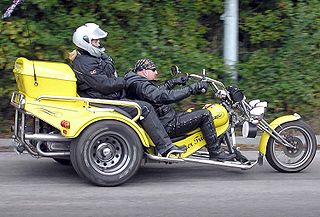
A motorized tricycle, motor trike, or motortrycle is a three-wheeled vehicle based on the same technology as a bicycle or motorcycle, and powered by an electric motor, motorcycle, scooter or car engine.

A multicab is a small light truck in the Philippines that is usually used as public transport. Just like jeepneys, they have fixed routes. Although, there are multicabs that serve as taxicabs where passengers go exactly where they want, as a tricycle might. Aside from being a mode of mass transportation, it can also be customized for other purposes such as a pickup truck or a private van.

The Public Utility Vehicle Modernization Program (PUVMP) is a program made by the Department of Transportation of the Philippines in 2017, with the goal of making the country's public transportation system efficient and environmentally friendly by 2020. The program calls for the phasing-out of jeepneys, buses and other Public Utility Vehicles (PUVs) that are at least 15 years old and replacing them with safer, more comfortable and more environmentally-friendly alternatives over the next three years. Currently, there are 220,000 jeepney units operating throughout the country.
Transportation within Cebu City is mainly land-based with most parts of the city accessible by road. There is no existing mass transit but construction is currently being undertaken on the Cebu Bus Rapid Transit System as well as an existing proposal for a Cebu Monorail, both of which will be crucial in solving the city's worsening traffic congestion, as existing transportation modes will soon become insufficient to move residents around the city if the local government fails to urgently implement infrastructure projects and measures to address the issue.

The tranvía was a streetcar system that served Manila and its surrounding cities during the early years of the 20th century.

Bagong Jeep, also known as the Bagong Jeepney, is a public transport service which maintains a fleet of minibuses and vans which are characterized as jeepneys.
